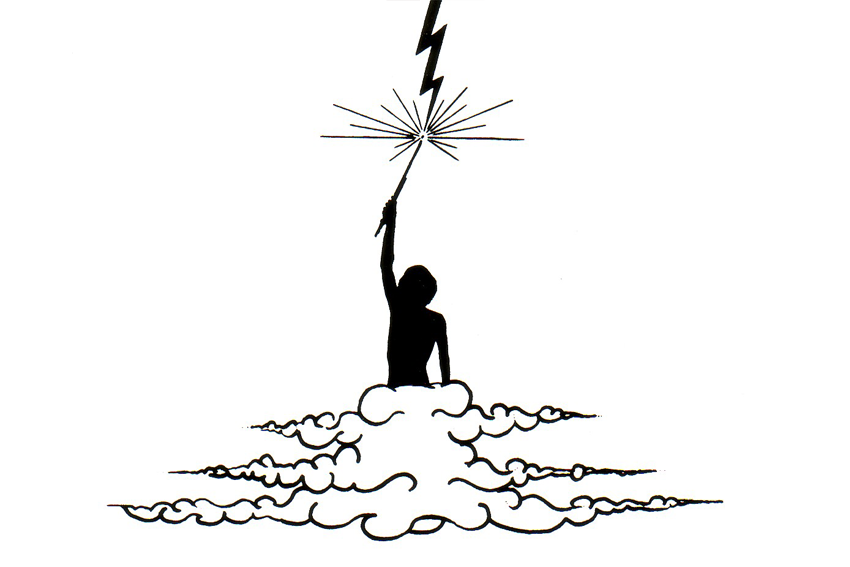Note: “Vibrational Gateway” and “Generating Paradise” were published as “Paradise Patterns: The Music and World of Iasos (1947-2024)” in Fantasy Audio Magazine #3 (2024).
Vibrational Gateway
Written by Descender
I think of a lot of my music as being a vibrational gateway to access higher dimensions. People can listen to the music and it can function as a ticket, a bridge, a gateway in consciousness to help them connect with, go to, and stay at a higher level of life. And using music for that purpose has always been a big fascination for me. (Iasos)
One of the most compelling questions I’ve wrestled with in my life is an albeit pedestrian one among those of entry-level existence philosophy. I think it must have been one of the PHILO courses during my undergrad, maybe “Love and Relationships” or something like that. The question was posed during a visiting lecture about Theravada Buddhism and its perspectives on living as a burning flame ignited by another–are the flames the same? This is something I think about pretty often and usually involuntarily, as it’s by design impossible to answer. It isn’t meant, probably, to be answered as no answers are correct. Instead, it is meant to encourage a reconsideration of identity, of uniqueness, of soleness, of transference. Composers of music are, in a sense, givers of gifts and sharers of ideas and feelings–I am paraphrasing Iasos when I say this, as I can’t recall the exact interview. Probably the one with Christopher Toussaint. There’s a reason that the creator of celestial music such as his stuck to forms that he called “higher-consciousness music”, despite legitimate experimentation throughout his years. The world in his eyes was rich in low-end, negative emotional tide, and Iasos had no interest in contributing to that pool. His gifts are healthful vibrations, his ideas shared with the intention to elevate listeners above the ostensible world.
I want to talk about appreciation with respect to music, or more general[ly], with respect to art. I encourage you when you are creating music to not try to please other people. Try to please yourself […] When you’re trying to please other people, you’re guessing, you’re stabbing in the dark, you don’t know, you don’t have a clue. When you try to please yourself, you know exactly what you like, you know exactly what you don’t like. Now here’s the bottom line, no matter what you create with music, there will always be some people that like it and there will always be some people that don’t like it–so here’s the basic formula for how it works. Art appreciation boils down to consciousness matching. If the person perceiving the music is in a similar consciousness or similar mindset as the one who created it, they’ll love it…if they’re on a different level of consciousness, they don’t get it at all and if they’re on a much higher level of consciousness it’s kind of crude and simple. For example, when I do my music I try to make it as celestial and heavenly as I can, but there are angels who are cruising way higher than me and they listen to my music and say “well God bless him, at least he’s trying! (Iasos, Tips for Aspiring Musicians)
I was really upset when I learned of Iasos’s passing in January of this year and for a variety of reasons felt that I’d made a tremendous mistake in the months beforehand. The first and comparatively lesser mistake was not seizing the opportunity to speak with him more when the door was open and he was there to speak. I’m incredibly fortunate to have been in communication with Iasos during the months of May and September of 2023 endeavoring to host an admittedly ambitious crowdfunding campaign to put together a box set of his work between he, his business advisor Carlos Niño and myself under the very – much – trying – to – just – stay – out – of – the – way Fantasy Audio Magazine label. I wanted to bring his music into the hands of those who would appreciate it in a fully-analog and, most importantly, affordable way that would make it possible to enjoy his catalog on physical media without having to contend with orcish Discogs merchants to do so. In the end, Iasos decided that such a box set was not necessary, but did like the idea of participating in another project that would include a full-scale interview with me. Naturally, I was thrilled by this opportunity and had opted to take a few months to consider what in the world I should ask the great Iasos. Unfortunately, this interview would not come to pass.
This was the lesser mistake–as enormous of an opportunity that would have been. In the end, we are already blessed with so much of his wisdom and creation that’s been uploaded and documented online for all to enjoy, and for free. The greater mistake was in my view discovering him so late in his career. His music ignited an appreciation in me from the get, and I’d have loved to attend one of his special lectures or concerts. To see him perform, so adept, keying at the Golden Harp, or to hear him speak so effortlessly on surreal, metasonic concepts that sound like at once supreme insight and Frank Herbert-esque angel lore, these are the experiences I have missed. I currently miss them as I miss the man. In what I believe would be in good Iasos spirit is the fact that there exists a proverbial silver lining to all of this: we have so much still to take in. The course of his output is a kind of star map through a cosmos of notions, each of them a light offering that burns equally as bright as that of its source. Again, that question–if a candle lights a second, are the two flames the same? In a sense, yes; in another, no. The music of Iasos is a similar thing (light, flame, etc) and bears a similar spiritual conundrum. His gift is not bound to his lifetime, nor is his resonance–it continues within our own spirits. Iasos is gone, and yet Iasos remains among us. Thank God.
PS: If you’re reading this from wherever you are now, I apologize for messaging at odd hours and always forgetting about Hawaii time!
Generating Paradise
Written by Kaptain Carbon
In 1979, a documentary was produced on the Greek new age musician Iasos. The documentary is a 30 minute compilation of the musician performing while cosmic visuals fade like ocean waves. Between these segments, an unnamed interviewer asks then 32 year old Iasos questions about his beliefs and music. Over a lush backdrop of Californian treeline, the first question posed was “you said this music came to you, where from?” There is a slight pause and a coy smile as if there is a lot to unpack with this question. Iasos proceeds to explain his worldview between gleeful bouts of laughter while assuring the questionnaire that “I realize this is hard for you to believe but at least I’m telling you what I believe and you are free to handle that reality anyway you like.” You can tell by this interaction that he knows how it sounds that he is a receiver to an interdimensional entity to recreate patterns that exist outside of our consciousness perception. Even at the time, Iasos probably was aware of how it sounded. By watching this clip you can also tell he couldn’t care less how others perceived him.
Iasos was one of the first musicians I encountered when researching new age music in a more serious tone. Looking at a timeline, his 1975 debut Inter-Dimensional Music Through Iasos was one of the first albums to have a fully synthesized ambient drone most commonly associated with what we think about when hearing the term “new age music.” Before 1975, the concept of new age was experimented through various esoteric and psychedelic circles ranging from musique concrete to chamber folk and mediation music. Inter-Dimensional Music Through Iasos was gentle but and calming but was also buried in effects and processing. Bird calls, flute, and the sliding electronic drone filled the soundscape with song titles embracing concepts like astrology, fantasy, mythology, and peaceful locations perhaps as a manifestation of the musician’s beliefs. This was truly precinct for 1975 as it seemed to lay a foundation for others to follow for the next decade for a new age.
Recently as far aback as the early 2010s, there has been a renaissance of appreciation of new age music ranging from exhaustive cataloging by labels like Light in the Attic and Numero Group to serious reevaluations by publications like Pitchfork and the New Yorker. Blogs like Sounds of the Dawn have been invaluable for the preservation of many of these records. There has been a conserved effort to approach this music as an underground phenomenon not unlike other sub mainstream music genres. Iasos might be on the obscure side for some in terms of music but is almost a household name for anyone journeying into the realm of new age. It was in this burgeoning of content I found the material necessary for an article on new age and with an appreciative tone which was far from derisive or pithy. It was also at this time that I found the 1979 documentary which showed the young Iasos talking about his music from his studio.
Among the innumerable recording devices and mixing boards Iasos stands smiling. It’s the same gleeful expression one can see in any child who is excited to talk about the things he loves. The bulky electronics, then futuristic at the time, whirl over the sound of a resonating drone. The drone is made by Iasos placing ornate weights on the keys to sustain notes and manipulated by the arcane looking mixing equipment. The setup seems both antiquated now but forecast an entire style of at home electronic music creation. The same unnamed interviewer asks him about the paradox between a “new age musician” spending so much time in “cybernetic environment.” Iasos once again smiles and discusses the concept of electrons being god beings and tools for humans to manipulate and recreate whatever we want. It is interesting how the concept of new age already had social norms and that this musician was already breaking them by fully embracing electronics.
I discuss these small bits of interaction that are now on this film as watching them helped me understand Iasos and new lenses in which to view his music. His albums, while peaceful and harmonious, can be relegated to the background if not actively paying attention. Watching these interviews very much shows the intent and the process in which Iasos worked from and the inspiration he drew from which is very much out of this world. This process of creation reminded me so much of current bedroom musicians using home studios to attain some sort of connection with another world. Maybe not exactly the same as pulling paradise patterns to earth from alternate beings but embracing the unknown and trying their best to translate it into music.
PS: If you’re reading this from wherever you are now, I wanted to thank you for inspiring me to make music without really knowing what im doing. It doesnt sound like what you made but I feel it comes from the same place of joy.
Throne Realms: A Listening Guide For Iasos (1975 – 1983)
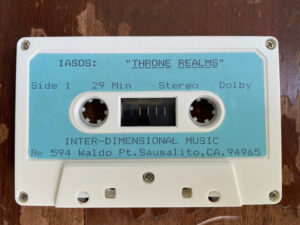 Note: This listening guide which originally ran in Fantasy Audio Magazine #3 has been updated and expanded for this article.
Note: This listening guide which originally ran in Fantasy Audio Magazine #3 has been updated and expanded for this article.
When I heard of Iasos’ passing, I knew I wanted to write something. His leaving from this world seemed to come at a unique time when his music was already playing in rotation. My parents were always supporters of mourning musicians, especially ones you had a connection with. I enjoy arranging guides for people to possibly help them into getting into the music I found so enjoyable. A guide also gives me a reason to fully invest myself in a catalog for a short period of time and arrange things for potential new visitors. I feel like Iasos would appreciate this as he spent so much of his life trying to bring something to others. Perhaps he would even just enjoy me being so fascinated with his work and the fact it brought me so much joy. Maybe he would be pleased to know I still think about him in his studio surrounded by sound making instruments and that image being a personal goal for my own art. He was so close to paradise and for all of his life seemed to want to bring its patterns to us and couldn’t contain that joy when talking about it.
Below is a guide to the early works of Iasos from his 1975 debut Inter-Dimensional Music Through Iasos to his 1983 release Wave 2: Elixir. The era from 1975-1983, in terms of discography with accompanying media, is the most documented. As extensive as the internet is about cataloging music, there are sections of Iasos’ discography that are not preserved. Vibrational Environment #2: Earth Calm/Space Calm (1979) and Vibrational Environment #4: Throne Realms & Lagoon Waves (1982) do not appear to be reproduced anywhere and streaming is non existent. For all intents and purposes these two records just exist as pictures. It is my belief this series was intended to be a functional piece of music which was either sold as a commodity or intended as promotion. Instances like this showcase the fragility of pre digital music with some slipping out of existence due to neglect or perceived lack of importance. I would love to listen to Throne Realms but for reasons beyond my control I can not.
For this guide, I have opted to use the pictures of the original cassettes or JCards. There is something intriguing about ethereal music contrasted with handmade tapes with flimsy stickers. The tape for Vibrational Environment #4: Throne Realms & Lagoon Waves (1982) is one of my favorites with a bright blue on faded white tape with the text almost looking like it was printed (maybe it was) This utilitarian and home made aesthetic is contrasted with fantastic titles like “Throne Realms” which looks like it offers immense escapism at the price of visual budget. Much like pulp fiction or paperback fantasy, there is a special space that exists between high concept and budget media. This is not an ironic love rather an appreciation for escapism through egalitarian services. These tape covers look like they were made by companies who offered everyday people a chance to make a record and the media which survives are artifacts of a cottage industry, one that we are all aware of now with Bandcamp, which existed before the internet. These tapes are just like the ones you have from artists now who crafted handmade tapes in edition of 25. Some of them exist only as pictures though for some they were the focal point of immense transcendence.
 Celestial Soul Portrait [Compilation] (2013)
Celestial Soul Portrait [Compilation] (2013)
As the case with most things, retrospective compilations are usually the best and most direct way to get an overview of an artist. This 2013 compilation produced by Numero Group gives a brief tour of Iasos from 1975 to 1983. Though over an hour in running time, it provides to most focued presentation of Iasos sound with tracks that are accessible if for only the fact they are at most 10 minutes long. Celestial Soul Portrait, much like its name, is a chance encounter with the artist which can fit into most activities such as reading, writting, and in my case, hours playing Morrowind. If these sounds are intriguing to you and you want to travel further, going chronologically, in my opinion, is the path which made the most sense to me.
Youtube
Spotify
Bandcamp
Discogs
Pitchfork Review
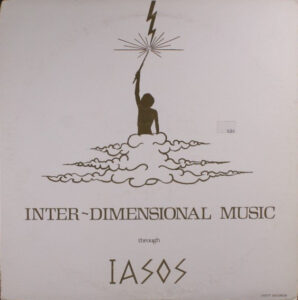 Inter-Dimensional Music Through Iasos (1975)
Inter-Dimensional Music Through Iasos (1975)
Inter-Dimensional Music Through Iasos was released in 1975 on Unity Records. The label was based in California with Iasos’ debut being the third in their catalog. This was the only release on Unity with all other material by Iasos on his own personal label Inter-Dimensional Music. This debut represents an opening statement by the artist and a collection of material he had been compiling in the mid 1970’s. Through field recordings, traditional instruments, manipulated sounds and heavily drone, Iasos debut can be thought of as the genesis of what we think of the new age sound. Its vision was daring all the while pushing for complete harmony with its experimental sound. It is also a record which I feel is the most commercial with songs broken up into 3-4 minute tracks instead of the future format of 30 minute tracks.
Youtube
Spotify
Bandcamp
Discogs
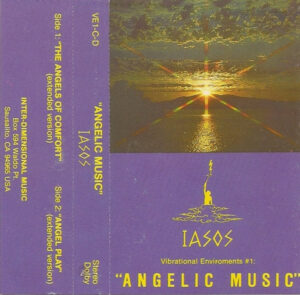 Vibrational Environments #1: Angelic Music (1978)
Vibrational Environments #1: Angelic Music (1978)
Vibrational Environments #1: Angelic Music was the inaugural start to a series of environmental ambience presented in two uninterrupted tracks of heavenly drone. Angelic Music, as it is now known, represented a shift between commercial records and functional records with this being close to a musical tool to guide a metaphysical process. Out of the four releases, Angelic Music is the most popular and easiest to find with two of the entries, as discussed before, not existing on the internet. While Inter-Dimensional Music Through Iasos is a phenomenal start into the discography of Iasos, Angelic Music, I feel is one of the most realized releases in his discography in a tape format which is befitting of the times. Angelic Music also has the distinction of being the closest to the music heard by people who had near death experience in a 1989 research study by Plymouth University. This small factoid was relayed to Vice Magazine in a 2014 interview but I cant verify its claims nor do I care to since I want to believe it is true.
Youtube
Spotify
Bandcamp
Discogs
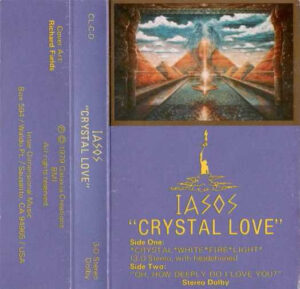 Crystal Love (1979)
Crystal Love (1979)
Iasos through many interviews has specific suggestions on how to listen to his music from the suggestion of headphones to listening at 60% of maximum comfort loudness. The tape cover for Crystal Love displays “3d Stereo Dolby” and is explained on the inside cover as being intended to generate a 3d hologram in the listeners consciousness. If one was to think of it that way then the hologram would consist of birds surrounding a hyper dimensional cube with lines receding into a focal point forever. Crystal Love is streamable on the Sounds of the Dawn as original cassettes have the same song repeated twice on each side with a long pause in between. Some versions of this album also have the subtitle “Vibrational Environments #7” which is confusing and also gets into an era where releases are less rigid in their structure.
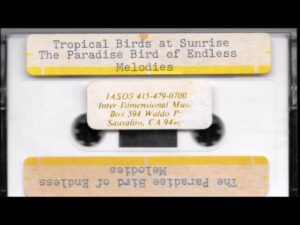 Vibrational Environments #3: Paradise Bird of Melodies (1980)
Vibrational Environments #3: Paradise Bird of Melodies (1980)
It is at this point where we get into the granular recordings of Iasos. It is my belief some of this music was not intended to be sold on a commercial level or in a way we think of most albums. The surviving covers for Vibrational Environments #3: Paradise Bird of Melodies (1980) are utilitarian with only a sticker indicating a California address and a larger title which floats above a white cassette. Vibrational Environments #3: Paradise Bird of Melodies is two sides with the first being 44 minutes of bird song and the second being a mix of birds and electronic ambient. Side B is perhaps most interesting to people but the world of structureless field recordings is close to drone and ambient. Vibrational Environments #3: Paradise Bird represents either the most functional or most artistic release by Iasos as it is the most non commercial.
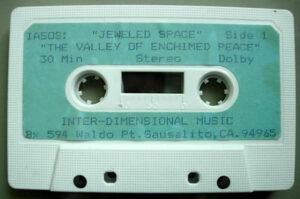 Jeweled Space (1981)
Jeweled Space (1981)
Jeweled Space might not appear different from previous entries as it is once again two tracks which take up two full sides of a cassette tape. In fact the two tracks are both 30 minutes long indicating the music was intended to be uniform and functional. Jeweled Space is perhaps the most approachable electronic ambient record as it is the most synthesized. It is also a release which is “subtle background music to be played at low volume.” Through two 30 minute tracks, the harmonies pulse and flow through corridors of ancient Greek architecture. Jeweled Space also has the track “the Royal Court of Goddess Vesta” which is the name of the interdimensional being that served as Iasos muse for his career. Vesta (or Vista?) is also known as Elohim of the 5th Ray, also known as Cyclopea and is the being which communicated paradise patterns through the musician.
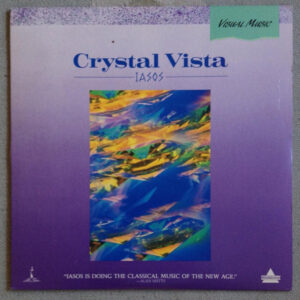 Crystal Vista (1981)
Crystal Vista (1981)
Crystal Vista is a 30 minute music film released on Laser Disc through the company Lumivision. It is previous music from Iasos combined with animated art from visionary painters. The artists used were Geoffery Chandler, Don Davis, James Fields, Richard Fields, Joseph Parker, Brian Mcgovern, Gilbert Williams, Benard & Barbra Xolotl with computer graphics from Mochael Oneil and Astral Vision,. I felt it necessary to list the artists in the credits as Crystal Vista is a treasure trove of near forgotten visionary art which existed in a specific time and place. Iasos once described his multimedia experiences in a Vice Magazine interview saying “music has the potential, the capability to induce divine emotions. Visuals have the capability to induce divine thought forms. When they work together synchronistically and synergistically their combined influence can ignite a person into a higher state of consciousness.” If that sort of thing sounds interesting let me also say the visuals are cosmic and have their own aesthetic now in 2024.
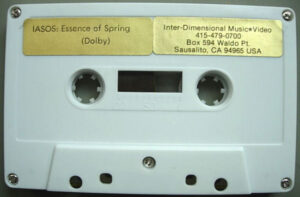 Essence of Spring (1983)
Essence of Spring (1983)
Though it feels like detective work piecing together Iasos discography, specifically when places like Discogs conflict with the artists website, 1983 feels like it was the end of an era for the artist. For the rest of the 1980’s and 1990s, Iasos redrafted his discography with the next wave of releases beginning in 1991. This also makes cataloging his work confusing as he seemed to be beyond traditional organization. Essence of Spring is split between celestial music on the first side with 30 minutes of water and bird sound on the second. The second side also comes with the instructions to “play at low volume” which feels on brand for an artist who seemed to be attentive to how his music was consumed.
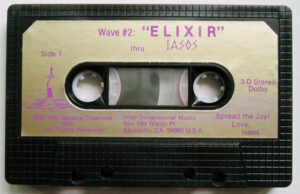 Wave #2: Elixir (1983)
Wave #2: Elixir (1983)
On the Bandcamp which was tended by the artist, Wave #2: Elixir was described as “one of Iasos’ most celestial albums and combines the richness of traditional symphonic music with the creative freedom of electronic music.” “Wave 2” denotes some sort of series regarding the release of records just as Vibrational Environments denoted a series. Inter-Dimensional Music Through Iasos also has the subtitle of Wave #1 but I am unaware if these titles are concrete or just an esoteric cataloging system. Wave #2: Elixir begins what I deem as a period where Iasos begins arranging his own discography for newcomers. Thios includes albums which are compilations and potentially reedits of previous works. Wave #2: Elixir is compoased of tracks from previous releases such as Angelic Music and Crystal Love. Though I am particularity interested in a traditional catalog, Wave #2: Elixir begins a new library of work for the artist which is above dates and concrete information. It is a release which is also intended for commercial purposes for people interested in celestial music without the need for specific dates.
Youtube
Bandcamp
Discogs

